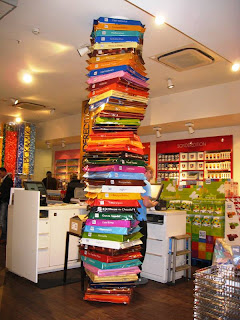
The Thread
by Victoria Hislop
narrated by Sandra Duncan
"Thessaloniki, 1917. As Dimitri Komninos is born, a fire sweeps through the thriving multicultural city, where Christians, Jews and Moslems live side by side. It is the first of many catastrophic events that will change for ever this city, as war, fear and persecution begin to divide its people."During the first month of the big commute, the only reading I was doing was in the car - at home I was too tired to concentrate on complicated words. This was good to listen to, superficially a love story, but it also taught me a little bit about the history of Greece since the 1920's.

The Hare with Amber Eyes: A Hidden Inheritance
by Edmund de Waal
"When Edmund de Waal inherited a collection of 264 tiny Japanese wood and ivory carvings, called netsuke, he wanted to know who had touched and held them, and how the collection had managed to survive."This was a book that I finished reading because I am faintly obsessive and hate to leave a book unfinished. No doubt it is a work of art, like the things it describes, and I could appreciate the quality of the writing, but it wasn't my cup of tea. Sister D gave it to me when she had finished reading it on our trip on the Danube, and when I asked if it was good, she kind of shrugged. I should have known from that reaction.

Appleby at Allington
by Michael Innes
narrated by Gordon Dulieu
"Sir John Appleby dines one evening at Allington Park, the Georgian home of his acquaintance Owain Allington, who is new to the area. The evening comes to an end, but just as Appleby is leaving, they find a dead man, electrocuted in the son et lumiere box that had been installed in the grounds."An author that was recommended to me by Hugh, a regular reader of this blog (while I am a regular reader of his weekly circular). He is right, it is old school detective fiction in the style of Dorothy L Sayers' Lord Peter Wimsey and Francis Durbridge's Paul Temple, both of which I like. This was just right, although the narration was a bit slow, with some heavy pauses. A proper whodunnit with a satisfactory conclusion, even if not an outstanding work of literature. But as I found with the previous book, literature can be a bit tedious sometimes.

The Wonderful Wizard of Oz
by L. Frank Baum
narrated by B. J. Harrison
"When a tornado crashes through Kansas city, Dorothy and her dog Toto are whisked far away, over the rainbow, to a strange land called Oz. Plucky Dorothy and Toto embark on a magical adventure to search for the Wizard of Oz and along the way encounter the Tin Woodman, the Scarecrow and the Cowardly Lion."Another freebie from the Classic Tales podcasts, and he didn't do too badly with the narration of this one - no difficult names or foreign words. Surprisingly similar and yet distinctly different from the movie version, Dorothy inherits white shoes rather than ruby slippers, and I'd forgotten the bit where the wizard flies off in a balloon, although Lola II tells me it's in the film. Easy listening, but engaging enough for adult reading.

The Man Who Knew Too Much
by G. K. Chesterton
narrated by B. J. Harrison
"The eight adventures in this classic British mystery trace the activities of Horne Fisher, the man who knew too much, and his trusted friend Harold March. Although Horne's keen mind and powerful deductive gifts make him a natural sleuth, his inquiries have a way of developing moral complications."Another English author narrated by the American, but not too bad - the mistaken emphasis on the wrong syllable of Westmorland can be forgiven. These are in the style of Father Brown but much more political and less straightforward 'whodunnit'. It was a very useful filler, because I finished the Appleby book before my next monthly audio book credit arrived!






